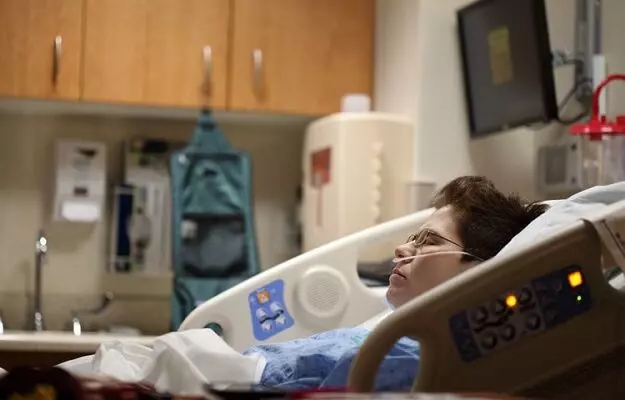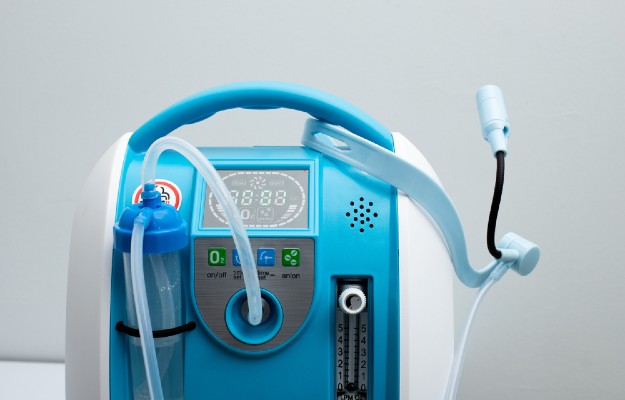Oxygen therapy refers to a treatment in which a patient is provided supplemental oxygen.
This therapy is given to those who are not able to get enough oxygen on their own. This can happen to those with lung diseases like asthma, chronic obstructive pulmonary disease (COPD) and pneumonia or other health conditions like heart failure and sleep apnea.
Oxygen therapy is also given to COVID-19 patients who experience respiratory distress and hypoxia (lack of oxygen in the body).
This therapy improves the blood oxygen levels of the patient and helps them feel better.
Read on to know more.
Read more: Ventilators for COVID-19 patients to have these special features
- What is oxygen therapy?
- How does your doctor know you need oxygen therapy?
- Types of oxygen therapy
- How is oxygen given to COVID-19 patients?
- Guidelines for using oxygen therapy at home
- Side effects of oxygen therapy
What is oxygen therapy?
Oxygen is an important gas that the human body needs to function and survive. It makes up about 21% of all the air you breathe. Your lungs absorb this gas and pass it over to your blood. Haemoglobin present in blood then carries this oxygen to all your body cells.
If you have a lung disease, your lungs may be inflamed or scarred and hence would be unable to pass on enough oxygen to your body. Low oxygen in blood is known as hypoxemia. On the other hand, hypoxia is a more severe condition in which the whole body or a body tissue does not get enough oxygen. Hypoxemia is the most common cause of hypoxia.
Your doctor may decide to give you oxygen therapy if you have low blood oxygen levels. If you have low oxygen levels, you may show the following symptoms:
- Shortness of breath
- Fast breathing
- Increased heart rate and blood pressure
- Tiredness
- Confusion
- Cyanosis (bluish discolouration of skin)
Tissue damage may occur due to lack of oxygen.
Oxygen therapy may be needed in the following conditions:
- Sleep apnea
- Pneumonia
- COPD
- Cystic fibrosis
- Last stage heart failure
- A severe asthma attack
How does your doctor know you need oxygen therapy?
Apart from the symptoms, your doctor may determine your blood oxygen levels through:
- Pulse oximetry: Pulse oximetry is a test in which a tiny clip like electronic device - a pulse oximeter - is used to find out how much oxygen is present in your blood (blood oxygen saturation). The device may be attached to your fingers, ears, foot, nose, toes, or forehead.
A pulse oximeter passes beams of light through your blood to read how much oxygen is present in your bloodstream. Normally, your blood oxygen saturation levels should be between 95 to 100%.
According to the American Thoracic Society, your body needs at least 89% oxygen saturation to be able to function properly. Supplemental oxygen is needed when the blood oxygen saturation levels fall below 89%. -
Arterial blood gas saturation: A blood gas test gives a more accurate measure of how much carbon dioxide and oxygen is present in your blood. It is used to test how efficiently your lungs are exchanging gases.
For this test, a doctor will take out blood from your artery to measure the amount of gases present in it.
Results of this test show:- Partial pressure of oxygen in blood: The partial pressure of oxygen (PaO2) explains how well your lungs are transferring oxygen to your blood. Normally, it is between 75 to 100 mmHg.
- Oxygen saturation
- Partial pressure of carbon dioxide in your blood
- Blood pH in arteries: pH indicates the number of hydrogen ions in the blood. It is written in numbers 0 to 14. pH below 7 is acidic while a pH above 7 is basic or alkaline.
Normal blood pH is between 7.38 to 7.4 - or slightly basic. Blood pH is maintained by various factors -increased blood carbon dioxide levels are one of the causes of low blood pH.
Oxygen therapy is given to patients when the partial pressure of oxygen in their blood falls below 60mm Hg.
Read more: Arterial Blood gas test
Types of oxygen therapy
Oxygen therapy is either given through face masks or tubes inserted into the patient’s nose or windpipe (trachea). The following devices are used to store and deliver oxygen:
- Oxygen concentrator: Oxygen concentrators are devices that can take the air you breathe and concentrate the oxygen level in it to about 85% to 95% - the normal oxygen level in air is 21%. This helps the patient’s lungs to take more oxygen. Bigger oxygen concentrators can weigh somewhere between 14 kg and 23 kg and can supply oxygen to the medical gas pipeline in hospitals, which can be made available to the patient’s bedside. Oxygen concentrators can also be portable and used at home. The portable ones are smaller and lighter but they supply less oxygen than an industrial oxygen concentrator. Some concentrators send a continuous oxygen supply while some send pulses of oxygen.
- Compressed gas cylinders: Compressed gas cylinders, as the name suggests, have oxygen compressed inside various sized containers/cylinders. The cylinders have 100% oxygen at a pressure of about 15169 kPa (kilopascal) and about 21 degrees Celsius. Larger sized cylinders are used in hospitals and can supply directly to the medical gas pipelines. Smaller cylinders can be used at home.
- Liquid oxygen: Oxygen takes up less space in liquid form. So, more oxygen can be stored at once. Liquid oxygen is prepared by cooling oxygen to a temperature of minus 300 degree Celsius. This method also provides 100% oxygen and can be used in large-sized or portable cylinders.
Read more: Five steps to kick out COVID-19 as per WHO
How is oxygen given to COVID-19 patients?
Oxygen delivery systems are of two types: low-flow delivery system and high-flow delivery system. The kind of delivery system you need would depend on various factors including where you are, how much oxygen you need, and whether you need oxygen only during day or day and night. Availability of electrical supply and cost of treatment determine the method used in some cases.
Here is what you need to know about delivery systems for oxygen therapy:
- Low-flow delivery systems: This kind of system only adds some oxygen to what the patient is breathing naturally. Usually, these systems don’t provide a known or constant oxygen supply. The amount of oxygen would vary, depending on how fast or slow the person is breathing. Some low-flow delivery systems are:
- Nasal Cannula: Nasal cannula is the most common device used to deliver oxygen. It is a tube with nasal prongs that are inserted into the patient’s nostrils and connected to an oxygen delivery system on the other end.
Nasal cannula is usually given to patients who need low levels of oxygen supplementation for a longer term. It provides anywhere between 24% and 40% oxygen and has a flow rate of 1 to 4 litres of oxygen/minute (L/min).
High flow of oxygen therapy can be done using a nasal cannula. However, more than 4 L/min of oxygen through a cannula can cause dryness in the nose. A humidifier is sometimes used to help patients with such cases.
With nasal cannula, the patient can easily eat or talk but the side effect is that the prongs can easily get out and may need adjustment frequently. - Face masks: A face mask is another kind of common oxygen delivery system. In this, an oxygen mask is put over the nose and the mouth of the patient. The mask is kept in its place with the help of a band that wraps around the person’s head. A face mask also has holes for exhaled carbon dioxide.
A face mask provides more oxygen concentration than a nasal cannula. However, the efficiency of the mask varies depending on how well it fits on the patient’s face. A normal face mask provides about 40% to 60% oxygen concentration at a rate of 6 to 10 L/min. - Non-re-breather mask: A non-re-breather mask has a bag attached to the flow meter on the mask - a flow meter is an instrument that regulates the flow of oxygen in the mask. There is a one-way valve between the mask and the bag so that the air only goes into the mask through the bag and not the other way around. The exhaled air goes out through the mask. This kind of mask is generally not available in general wards since it provides a high amount of oxygen - 60% to 80% oxygen at a rate of 10 to 15 L/min.
- Partial re-breather mask: A partial re-breather mask is another high-flow oxygen system. However, unlike the non-re-breather mask, this one has a partially inflated bag attached to the flow meter. Mixing of air does take place in this kind of mask. This type of mask is used only for a short period in patients who need a lot of oxygen supplementation. It provides oxygen at a concentration of 80% to 90% and at a rate of 10 to 12 L/min.
- Nasal Cannula: Nasal cannula is the most common device used to deliver oxygen. It is a tube with nasal prongs that are inserted into the patient’s nostrils and connected to an oxygen delivery system on the other end.
- High-flow delivery system: These kinds of devices give the total amount of air the person is breathing. High-flow delivery systems are generally given to patients who need a precise and constant supply of oxygen. Some examples of this kind of oxygen delivery systems are:
- Venturi mask: A venturi mask is a high-flow oxygen therapy mask. However, it can provide a wide range of 24% to 60% or more of oxygen at a flow rate between 4 to 12 L/min. The flow of oxygen in this mask can be adjusted as per the patient’s need.
- Transtracheal catheters: Transtracheal catheters are inserted directly into the patient’s trachea (windpipe) through a small surgery. These high-flow devices can provide oxygen concentration between 60% to 100% and at a flow rate between 0.25 to 4 L/min. The benefit of this device is that it can be hidden easily under the clothes and is much more comfortable than a nasal cannula. However, a transtracheal catheter needs more frequent cleaning since the tube is directly inserted inside the body.
- Other high-flow delivery systems: Some other oxygen devices include T-tube, tracheostomy collars, and face tents. These are a high-oxygen flow tube used to wean people off ventilator support. All these devices are attached with nebulisers that generate aerosols and provide between 30% and 100% oxygen at a rate of 8 to 10 L/min.
- Pulse dose devices: These are oxygen-conserving devices that provide oxygen only when the person inhales - they generate a pulse of oxygen. These devices can save up to 75% of the oxygen used and can provide between 10 to 40 mL of oxygen per breath. Almost all kinds of oxygen storage devices - liquid, concentrated or cylinders can be used with this kind of system. However, a downside is that if a person can’t breathe in strongly, their inhalation would not trigger the device. For such people, a pulse dose device can’t be used.
- Continuous positive airway pressure (CPAP) therapy: Continuous positive airway pressure (CPAP) therapy is typically used for those with sleep apnea. These devices may be in the form of masks or nasal cannula and have a motor attached that blows air into the tube. A CPAP device maintains air pressure so that the patient’s airways remain open and they are able to breathe properly while asleep. The only downside to these devices is that the patient may feel a bit claustrophobic and it may lead to a runny nose.
- Hyperbaric oxygen therapy: In hyperbaric oxygen therapy, the patient is kept in a small chamber - big enough to sit in or lie down - where he/she only breathes pure oxygen. It is given to patients with infections that lead to hypoxia, certain types of wounds and carbon monoxide poisoning. This therapy increases the total concentration of oxygen in tissues, improving healing and reducing the growth of harmful bacteria. Studies show that hyperbaric oxygen therapy is effective against the HIV virus. It increases the number of free radicals in the body, so the virus has no place to hide outside the person’s DNA.
Hyperbaric therapy is only given to those who have a lung disease, cold, fever or an ear trauma or surgery of the ear. This therapy is not just given to everyone and even those who get this therapy only sit in the chamber for about two hours in one session.
Read more: ELISA antibody test for COVID-19
Guidelines for using oxygen therapy at home
Oxygen therapy can be a lifesaver. That said, it is a medical intervention and like all such interventions, it should only be taken under the guidance of a healthcare professional.
Those getting oxygen therapy at home must follow these guidelines:
- Avoid smoking near the device. Though oxygen is not itself combustible, it supports flames. So keep the device at a distance of at least 2 meters from any flame and absolutely avoid smoking if you are on oxygen therapy.
- Store the cylinders properly so they don’t fall off and/or leak.
- Make sure all the electrical equipment in your house is in good working condition so there is no sparking, especially near the cylinder or the oxygen delivery device.
- Always be aware of how much oxygen the device has, if you or the patient is travelling.
Read more: Home-based care for COVID-19
Side effects of oxygen therapy
Normally, oxygen therapy is considered to be safe. However, it may have some of the following side effects:
- Drowsiness
- Headaches, especially in the morning
- Feeling tired
- Dry or bloody nose
Some side effects of hyperbaric oxygen therapy include claustrophobia, ear pressure, headache and fatigue.
If you notice any of the above side effects, talk to your doctor.
Long term exposure to high levels of oxygen (more than what you need) may lead to oxygen toxicity in some people - this is basically why you should never take oxygen therapy without talking to a doctor. Oxygen toxicity may lead to inflammation of bronchi (airways of the lungs) and trachea (windpipe) and it may further damage alveoli (air sacs present in lungs). The effects of oxygen toxicity show up within 24 hours and may manifest in the form of chest pain, heaviness and difficulty breathing.
Read more: Can you get coronavirus infection twice
Doctors for What is oxygen therapy?

Dr Rahul Gam
Infectious Disease
8 Years of Experience

Dr. Arun R
Infectious Disease
5 Years of Experience

Dr. Neha Gupta
Infectious Disease
16 Years of Experience

Dr. Anupama Kumar
Infectious Disease
Medicines / Products that contain What is oxygen therapy?
- Proctosedyl BD Cream - ₹108
- Anovate Cream - ₹140
- Pilo GO Cream - ₹80
- Covifor Injection - ₹3780
- Fabiflu 200 Mg Tablet - ₹1292
- Fabiflu 400 Tablet - ₹856
- Fabiflu (Favipiravir) 400 Mg Tablet - ₹1224
- Fabiflu (Favipiravir) 200 Mg Tablet - ₹1292
- Remdesivir Injection - ₹10500
- Molusafe Capsule - ₹457
- Movfor 200 Mg Capsule - ₹2490
- Molflu 200 Mg Capsule - ₹1400
- Molulife 200 Capsule - ₹1399
- Cipmolnu 200 Mg Capsule - ₹2000
- Molxvir 200 Mg Capsule - ₹1520
- Immunocin Alpha Plus 1.6mg Injection - ₹5998
- Alzumab Injection - ₹8229
- Imualfa 1.6mg Injection 1ml - ₹2628
- Molnutor 200 Mg Capsule - ₹2000
- Sotrovimab Injection - ₹165000
- Nirmatrelvir - ₹5000
- Molnupiravir 200 Mg Capsule - ₹1400
- Covihalt 200 Tablet - ₹465
- Ciplenza Tablet - ₹646
- Itolizumab Injection - ₹8220
References
- Jacob SamuelCory Franklin. Hypoxemia and Hypoxia. In: Saclarides Theodore J., Myers Jonathan A., Millikan Keith W. eds. Common surgical diseases: An algorithmic approach to problem solving. Springer. 2015.
- Doyle Glynda Rees and McCutcheon Jodie Anita. Clinical Procedures for Safer Patient Care. 2015. Medicine.
- Science Direct (Elsevier) [Internet]; Hypoxia
- Da Zhang, Jin She, Zhengbo Zhang, Mengsun Yu. Effects of acute hypoxia on heart rate variability, sample entropy and cardiorespiratory phase synchronization. Biomed Eng Online. 2014; 13: 73. PMID: 24920347.
- MedlinePlus Medical Encyclopedia [Internet]. US National Library of Medicine. Bethesda. Maryland. USA; Oxygen Therapy
- British lung foundation [internet]. London. UK; Breathing and lung function tests
- American Lung Association [internet]. Chicago. Illinois. US; Pulse Oximetry
- American Thoracic Society [Internet]. NY. US; Pulse Oximetry
- Benioff Children's Hospital [internet]. University of California. San Francisco. US; Blood Gases
- Sharma S, Hashmi MF, Rawat D. Partial Pressure Of Oxygen (PO2) [Updated 2019 Sep 13]. In: StatPearls [Internet]. Treasure Island (FL): StatPearls Publishing; 2020 Jan
- Merck Manual Consumer Version [Internet]. Kenilworth (NJ): Merck & Co. Inc.; c2018. Overview of Acid-Base Balance
- Trulock EP III. Arterial Blood Gases. In: Walker HK, Hall WD, Hurst JW, editors. Clinical Methods: The History, Physical, and Laboratory Examinations. 3rd edition. Boston: Butterworths; 1990. Chapter 49.
- American Thoracic Society [Internet]. NY. US; Oxygen Therapy
- College of Respiratory Therapists of Ontario [Internet]. Ontario. Canada; Oxygen Therapy
- Cooper University Healthcare [Internet]. New jersey. US; Trans-tracheal Catheter Insertion and Trans-tracheal Oxygen Therapy
- US San Diego Health [Internet]. California. US; Transtracheal Oxygen Catheter (TTO)
- Suzanne C. O'Connell Smeltzer, Brenda G. Bare, Janice L. Hinkle, Kerry H. Cheever. Brunner & Suddarth's Textbook of Medical-surgical Nursing. Ist edition. Wolters Kluwer,
- American Association of Sleep Technologists [Internet]. Illinois. US; What is CPAP (Continuous Positive Airway Pressure) Therapy?
- Baugh MA. HIV: reactive oxygen species, enveloped viruses and hyperbaric oxygen. Med Hypotheses. 2000;55(3):232–238. PMID: 10985915
- Johns Hopkins Medicine [Internet]. The Johns Hopkins University, The Johns Hopkins Hospital, and Johns Hopkins Health System; Hyperbaric Oxygen Therapy
- National Heart, Lung, and Blood Institute [Internet]. Bethesda (MD): U.S. Department of Health and Human Services; Oxygen Therapy
- Cooper JS, Shah N. Oxygen Toxicity. [Updated 2019 May 20]. In: StatPearls [Internet]. Treasure Island (FL): StatPearls Publishing; 2020 Jan


















